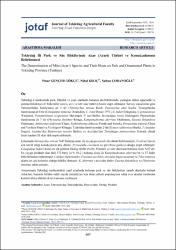| dc.description.abstract | Harmful, predatory and neutral mites were identified of ornamental plants, defoliant trees, shrubs (47 plant species) of in parks, nurseries and green areas in centre of Tekirdag province.According to the survey results, totally 20 mite species were identified as follows: two species belonged to the Tetranychidae family (Tetranychus urticae Koch, Panonychus ulmi Koch), eight species belonged to the Tenuipalpidae family (Cenopalpus spinosus Donnadieu, C.irani Dosse (1971), C.bakeri Duzgunes, C.pennasitesus Wainstein, Pentamerismus oregonensis McGregor, P. taxi Haller, Brevipalpus lewisi McGregor); 8 species belonged to the Phytoseiidae family (Phytoseusfinitimus Ribaga, Kampimadromus aberrans Oudemans, Euseius finlandicus Oudemans, Amblyseius andersoni Chant, Typhlodromus athiasae Porath and Swisrki, Paraseiulus triporus Chant and Yoshida-Shaul ve P.soleigner Ribaga); 2 species belonged to the Tydeiidae family (Tydeus californicus Banks, T.caudatus Duges), Blattisocius tarsalis Berlese from Ascidae and Tyrophagus putrescentiae Schrank from Acaridae.Tetranychus urticae was found as the most common harmful mite species with 47% prevalance rate in the study. Firethorn (Pyracantcha coccinea) and the rose (Rosa gallica) were determined as the most preferred host plants by T.urticae. Cenopalpus bakeri was the second common phytophagus species (30%). Prevalance rate of predatory and neutral mites was estimated as 57%. The most common predatory mite species found as Kampimodromus aberrans, with 172 individuals and 56.21% frequency and they were collected from 17 different plant species. Catalpa bignonioides, Fraxinus excelsior, Aesculus hippocastanum and Tilia tometosa were the most preferred hosts to colonise by this species. K. aberrans was followed by predatory mite species Euseius finlandicus and Phytoseius finitimus.The study showed that park and ornamental plants, in green areas in centre of Tekirdag are infested with harmful mite species; however, since they were not in substantial numbers, it was believed that predatory mite their higher population species might probably control them because of densities. | en_US |



















